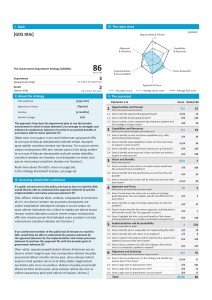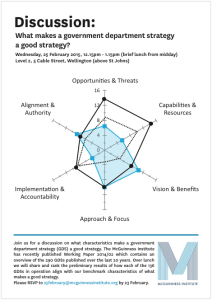This Wednesday we are launching our first ever Index, comparing 136 government departments strategies against each other, across departments and across sectors. If you would like to attend the launch, join us midday at the Institute. Please RSVP to [email protected]
No government institution regularly reviews the content of government department strategies (GDSs). There is no register kept of which GDSs are in operation. There are no guidelines suggesting how a GDS should be written. GDSs do not need to be signed by anyone, they do not need to be dated nor do they need to include information about their expected duration or the likelihood of an ongoing review process. There is no institution that the public is able to engage with in order to discuss the poor content of a government department strategy, or the way that a department might have failed to engage with stakeholders of GDSs. There is no central register of invitations to comment on GDSs. To put it bluntly, there is no feedback loop, no transparency and no accountability.
This is surprising for five reasons:
1. When analysing the data on the creation of GDSs over the period of the last twenty years, it is evident that New Zealand is creating a larger amount of GDSs as time goes on. See Figure 9 on page 15 of Working Paper 2020/02 for an illustration of this.
2. GDSs use a large amount of resources within departments and therefore their creation must be a large expense and investment for departments.
3. GDSs, once approved by the department or the relevant minister, often drive change over long periods. Sometimes they (and their visions) persist over successive governments. This data is based on analysis which can be read in Working Paper 2020/02 (Figure 16, page 18).
4. GDSs are public documents which not only provide a window into the working of government but often invite public engagement early on in their creation. The drafting of GDSs provides an opportunity for the crowd sourcing of ideas, the generation of consensus (such as agreements within particular groups to make trade-offs in the short term for long term gains) and collaboration with the wider community (such as businesses, philanthropists and councils).
5. GDSs are critical instruments able to bring about change. They track and describe the means to desired ends. However if there is no due diligence as to the content and structure of GDSs, they may in fact operate solely as blunt instruments – delivering the public more harm than good.
The purpose of the Institute’s research is to put a spotlight on GDSs. By doing so it aims to add value to a discussion on how New Zealand might create GDSs that are more effective at delivering outcomes, more cost-efficient at delivering value and more durable through increased transparency, engagement and fostering of public trust.
The crux of the research question is the extent to which each GDS in operation contains the essential elements of a good strategy document. It seeks also to highlight existing strategies which are exemplars of good practice.
A sample of the profile we are preparing for each government department strategy is attached below. We think this is the first attempt at benchmarking government department strategies around the world. It would be terrific if you could join us; your feedback will be most useful when preparing the written report later this year.























![20160906 McGuinness Institute - TacklingPovertyNZ Workshop – Far North Flyer [FINAL]](/wp-content/uploads/20160906-McGuinness-Institute-TacklingPovertyNZ-Workshop-%E2%80%93-Far-North-Flyer-FINAL-1-50x50.png)